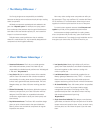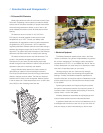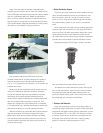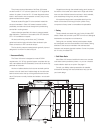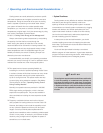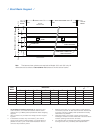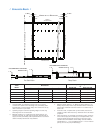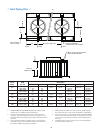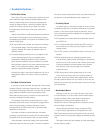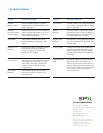
6
/ Operating and Environmental Considerations /
C a u t i o n
The cooling tower must be located at such distance and direction
to avoid the possibility of contaminated tower discharge air
being drawn into building fresh air intake ducts. The purchaser
should obtain the services of a Licensed Professional Engineer
or Registered Architect to certify that the location of the tower
is in compliance with applicable air pollution, fire, and clean
air codes.
Cooling towers are usually selected to produce a specic
cold water temperature at the higher summertime wet-bulb
temperatures. During the remainder of the year, the cooling
tower is capable of producing much colder water. Unless
your system will benet from the coldest possible water
temperature, you may want to consider controlling cold water
temperatures to higher levels. You'll also save energy by using
such control. See Marley Technical Report
#H-001A, “Cooling Tower Energy and its Management”.
Always control leaving water temperature by manipulating
the quantity of air that the fan moves through the
tower. Varying the quantity of water ow is not normally
recommended and can be harmful in freezing weather. You
can alternately start and stop single-speed motors to keep
water temperatures within an acceptable range. But your
exibility is limited by the amount of starting time per hour
allowed by the motor manufacturer.
Increased exibility can simplify your operating procedures
and save you money in the long run, both on operation and on
maintenance. Here are two of the more popular options:
❑ Two-speed motors improve operating exibility by
increasing the number of potential operating modes. Users
in northern climates will nd that the tower can carry winter
loads at half-speed; reducing fan power requirements
by 85+% during that time. Two-speed motors also help
to control icing during wintertime operation. See Marley
Technical Report #H-003, “Operating Cooling Towers
During Freezing Weather”.
Normally, two-speed motors are provided in 1800/900
RPM, single winding conguration, which is the least
expensive two-speed option. They are also available in
other combinations including the more expensive double
winding.
❑ Frequency modulation devices work well on induced
draft, propeller fan cooling towers such as the Class 160.
However, their design must include the capability to lock
out any critical fan speeds and the very low fan speed
ranges. Consult your Marley sales representative for
specic recommendations when considering variable speed
control. In many cases, for example, you'll achieve the best
results by using a single control to regulate the speed of
several fans on a multicell tower.
■ System Cleanliness
Cooling towers are very effective air washers. Atmospheric
dust able to pass through the relatively small louver
openings will enter the circulating water system. Increased
concentrations can intensify system maintenance by clogging
screens and strainers; and smaller particulates can coat
system heat transfer surfaces. In areas of low ow velocity
(such as the cold water basin), sedimentary deposits can
provide a breeding ground for bacteria.
In areas prone to dust and sedimentation, you should
consider installing some means for keeping the cold water
basin clean. Typical devices include side stream lters and a
variety of ltration media.
You should also plan ahead to develop a consistent,
effective program of water treatment. A good water treatment
program will help to assure long service life, while keeping your
tower free of potentially harmful biological growths.




